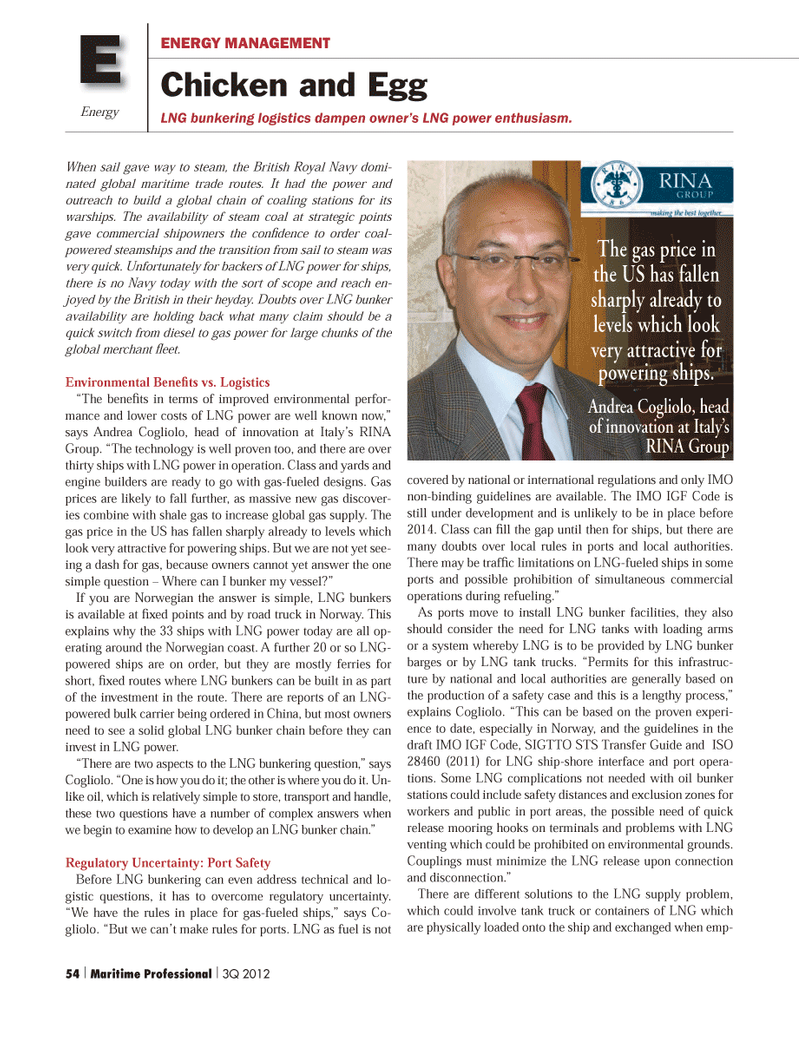
Page 54: of Maritime Logistics Professional Magazine (Q3 2012)
Classification Societies, Quality & Design
Read this page in Pdf, Flash or Html5 edition of Q3 2012 Maritime Logistics Professional Magazine
When sail gave way to steam, the British Royal Navy domi-nated global maritime trade routes. It had the power and outreach to build a global chain of coaling stations for its warships. The availability of steam coal at strategic points gave commercial shipowners the conÞ dence to order coal- powered steamships and the transition from sail to steam was very quick. Unfortunately for backers of LNG power for ships, there is no Navy today with the sort of scope and reach en- joyed by the British in their heyday. Doubts over LNG bunker availability are holding back what many claim should be a quick switch from diesel to gas power for large chunks of the global merchant ß eet. Environmental BeneÞ ts vs. Logistics?The bene ts in terms of improved environmental perfor- mance and lower costs of LNG power are well known now,? says Andrea Cogliolo, head of innovation at Italy?s RINA Group. ?The technology is well proven too, and there are over thirty ships with LNG power in operation. Class and yards and engine builders are ready to go with gas-fueled designs. Gas prices are likely to fall further, as massive new gas discover- ies combine with shale gas to increase global gas supply. The gas price in the US has fallen sharply already to levels which look very attractive for powering ships. But we are not yet see- ing a dash for gas, because owners cannot yet answer the one simple question ? Where can I bunker my vessel?? If you are Norwegian the answer is simple, LNG bunkers is available at xed points and by road truck in Norway. This explains why the 33 ships with LNG power today are all op- erating around the Norwegian coast. A further 20 or so LNG- powered ships are on order, but they are mostly ferries for short, xed routes where LNG bunkers can be built in as part of the investment in the route. There are reports of an LNG- powered bulk carrier being ordered in China, but most owners need to see a solid global LNG bunker chain before they can invest in LNG power. ?There are two aspects to the LNG bunkering question,? says Cogliolo. ?One is how you do it; the other is where you do it. Un- like oil, which is relatively simple to store, transport and handle, these two questions have a number of complex answers when we begin to examine how to develop an LNG bunker chain.? Regulatory Uncertainty: Port Safety Before LNG bunkering can even address technical and lo- gistic questions, it has to overcome regulatory uncertainty. ?We have the rules in place for gas-fueled ships,? says Co- gliolo. ?But we can?t make rules for ports. LNG as fuel is not covered by national or international regulations and only IMO non-binding guidelines are available. The IMO IGF Code is still under development and is unlikely to be in place before 2014. Class can ll the gap until then for ships, but there are many doubts over local rules in ports and local authorities. There may be traf c limitations on LNG-fueled ships in some ports and possible prohibition of simultaneous commercial operations during refueling.? As ports move to install LNG bunker facilities, they also should consider the need for LNG tanks with loading arms or a system whereby LNG is to be provided by LNG bunker barges or by LNG tank trucks. ?Permits for this infrastruc- ture by national and local authorities are generally based on the production of a safety case and this is a lengthy process,? explains Cogliolo. ?This can be based on the proven experi- ence to date, especially in Norway, and the guidelines in the draft IMO IGF Code, SIGTTO STS Transfer Guide and ISO 28460 (2011) for LNG ship-shore interface and port opera- tions. Some LNG complications not needed with oil bunker stations could include safety distances and exclusion zones for workers and public in port areas, the possible need of quick release mooring hooks on terminals and problems with LNG venting which could be prohibited on environmental grounds. Couplings must minimize the LNG release upon connection and disconnection.? There are different solutions to the LNG supply problem, which could involve tank truck or containers of LNG which are physically loaded onto the ship and exchanged when emp- Energy ENERGY MANAGEMENT Chicken and EggLNG bunkering logistics dampen owner?s LNG power enthusiasm. The gas price in the US has fallen sharply already to levels which look very attractive for powering ships. Andrea Cogliolo, head of innovation at Italy?s RINA Group E54 | Maritime Professional | 3Q 2012

 53
53

 55
55
